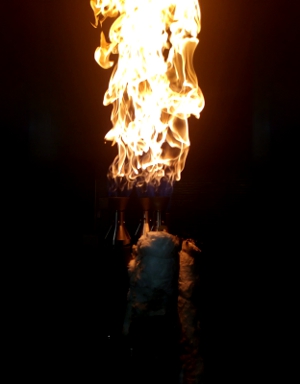 |
| March 11, 2025 | Volume 21 Issue 10 |
Designfax weekly eMagazine
Archives
Partners
Manufacturing Center
Product Spotlight
Modern Applications News
Metalworking Ideas For
Today's Job Shops
Tooling and Production
Strategies for large
metalworking plants
Engineers create more effective flare burner to reduce methane emissions
Researchers at the Southwest Research Institute (SwRI) and the University of Michigan (U-M) have published a new study showing an advanced new methane flare burner, created with additive manufacturing and machine learning, eliminates 98% of methane vented during oil production. The burner was designed by U-M engineering researchers and tested at SwRI.
Oil producers can generate methane during oil production and typically use flare stacks to burn off this gas. However, wind blowing across conventional open-flame burners reduces their effectiveness, releasing 40% or more of methane into the atmosphere. Over 100 years, methane has 28 times greater global warming potential than carbon dioxide and is 84 times more potent on a 20-year timescale, according to SwRI. Flaring reduces overall global warming potential, but ineffective flaring dampens this strategy.
SwRI collaborated with U-M engineers to leverage machine learning, computational fluid dynamics, and additive manufacturing to create and test a burner with high methane destruction efficiency and combustion stability at the challenging conditions present in the field.

Researchers at the Southwest Research Institute and the University of Michigan developed and tested an advanced methane flare burner that eliminated 98% of methane vented during oil production. [Credit: Photo courtesy of SwRI]
"We tested the burner at an indoor facility at SwRI, where we could control the crosswind and measure burner efficiency under different conditions," said SwRI Principal Engineer Alex Schluneker, one of the paper's co-authors. "Even the slightest amount of crosswind significantly reduced the effectiveness of most burners. We found that the structure and motions of the fins inside the burner were essential for maintaining efficiency. The U-M team engineered it to significantly improve performance."
The new burner has a complex nozzle base that splits the flow of methane in three different directions. The impeller design guides the gas toward the flame. This novel design allows for the even mixing of oxygen and methane and provides time for the combustion to occur before crosswinds can affect it. This design is key to the burner's efficiency.
"A good ratio of oxygen to methane is key to combustion," said SwRI Senior Research Engineer Justin Long. "The surrounding air needs to be captured and incorporated to mix with the methane, but too much can dilute it. U-M researchers conducted a lot of computational fluid dynamics work to find a design with an optimal air-methane balance, even when subjected to high-crosswind conditions."
SwRI and U-M teams are continuing to collaborate on creating and testing new burner designs, aiming to create an even more efficient and cost-effective prototype this year.
See "An Experimental Study of the Effects of Waste-Gas Composition and Crosswind on Non-assisted Flares Using a Novel Indoor Testing Approach" in Industrial & Chemical Engineering Research.
For more information, visit SwRI's Metering Research Facility or Fire Testing or contact Joanna Quintanilla, +1 210 522 2073, Communications Department, Southwest Research Institute.
Source: Southwest Research Institute
Published March 2025
Rate this article
View our terms of use and privacy policy
